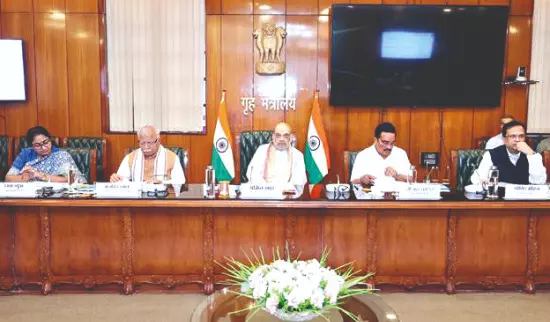
New Delhi, July 11 -- In a major step towards cleaning and restoring the Yamuna River, Union Home Minister and Cooperation Minister Amit Shah on Friday chaired a high-level review meeting in the national capital with Delhi Chief Minister Rekha Gupta and senior officials to finalise a joint action plan between the Centre and the Delhi government. The mission includes a Rs 9,000 crore comprehensive blueprint aimed at river rejuvenation, water infrastructure upgrades, and sewerage overhauls.
The review meeting saw the participation of Union Housing and Urban Affairs Minister Manohar Lal Khattar, Union Jal Shakti Minister C.R. Patil, Delhi Public Works Department Minister Parvesh Verma, Union Home Secretary Govind Mohan, Delhi Chief Secretary Naresh Kumar, and top officials from concerned ministries and the Delhi government.
During the discussion, Shah emphasised the need for an "integrated and time-bound" strategy to tackle the Yamuna's pollution levels and restore ecological balance. "The Yamuna is not just a river, it is the lifeline of Delhi. Its rejuvenation is a top priority and will be pursued with full coordination between the Centre and the Delhi government," he said.
Shah further stressed that the Delhi Pollution Control Committee (DPCC) must work in "action mode" to curb rising pollution levels. He urged the Delhi government to implement ongoing and stringent measures to control industrial pollution and highlighted that chemical waste from neighbouring states also ends up in the Yamuna. He called for coordinated efforts from all affected states, particularly Haryana and Uttar Pradesh.
Chief Minister Rekha Gupta echoed Shah's sentiment, stating, "This is not just an environmental issue, it's about public health, dignity, and the future of our capital. We are committed to delivering results that people can see and feel."
The Rs 9,000 crore initiative, driven by the Delhi Jal Board under CM Gupta's leadership, includes a 45-point action plan addressing water supply augmentation, sewage treatment, increased tanker service transparency, and direct river revival. The project is expected to be completed by the end of next year.
Shah placed special focus on improving Biochemical Oxygen Demand (BOD) in the Najafgarh and Shahdara drains, key pollution contributors. He recommended drone surveys of these drains and advocated increased funding for the National Mission for Clean Ganga (NMCG).
The action plan includes modernising sewer networks, stricter discharge rules for industrial effluents, and building green buffers along the river. Sixty-seven pollution hotspots have been identified, with a survey due by July's end.
Shah also called for STP capacity in Delhi to be increased to 1,500 MGD by 2028, along with third-party quality testing and inter-state monitoring. He advised using city reservoirs for rainwater harvesting and eco-tourism and suggested collaboration with the National Dairy Development Board (NDDB) to manage waste from dairies and unauthorised gaushalas.
PWD Minister Parvesh Verma confirmed that LG VK Saxena and CM Gupta are personally monitoring progress. "This level of accountability ensures that the mission does not remain on paper. We are working on war footing," he said. Finally, Shah urged the Delhi Jal Board to create a detailed water demand survey and phased plan to regulate borewell usage, ensuring long-term water security for the capital.
Published by HT Digital Content Services with permission from Millennium Post.
